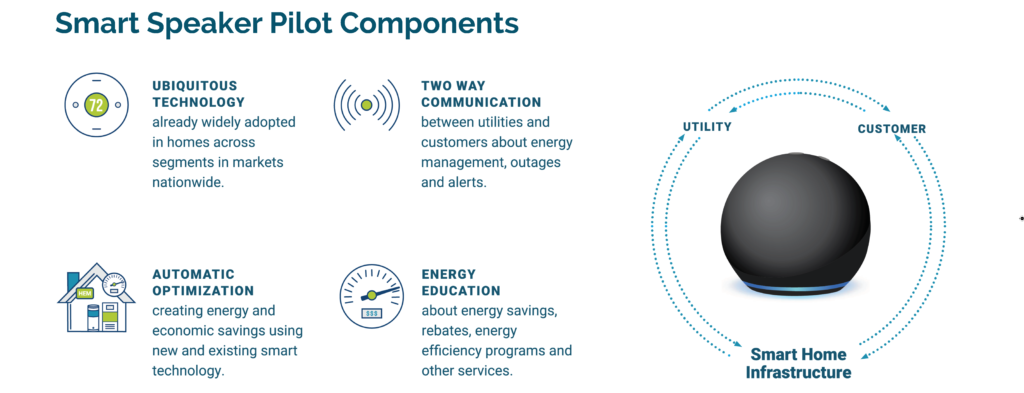
Southern California Edison (SCE), San Diego Gas & Electric (SDG&E) and Pacific Gas & Electric (PG&E) completed a coordinated trio of projects in 2021, under the Demand Response Emerging Technologies (DRET) Collaborative, effectively demonstrating that smart speakers offer a highly promising channel for utilities to reach residential customers and facilitate beneficial changes in the way they use energy. These projects each utilized “smart speakers” as a voice-activated gateway in assessing the ability for customers to interact with Amazon Alexa skills software and hardware solutions that created an intuitive interface between the smart speakers, the utility, in-home connected smart appliances and the customer.
Essentially, the customer either downloads an app to their phone or self-installs an easily available in-home device, linking their utility account and smart devices. This solution leverages a voice activated assistant to create a pathway for two-way instantaneous verbal communication between the utility and the customer about energy usage, outages and alerts. It also enabled the customer to manage their smart devices in the home for maximizing energy savings, without having to individually control or program each end use.

IOU Pilots
The SCE and PG&E pilots utilized the “Energy Expert” Amazon skills technology developed by Universal Devices (UDI). The Energy Expert enables customers to interact with their home’s energy use using their smart speaker, providing customers with cost estimates, time-of-use (TOU) pricing, rate plan comparison and historical data, while also allowing customers to optimize their energy use through messaging, analytics, and end device integration. The skill was originally developed as part of a transactive energy project in Southern California and then advanced through follow up development for time of use rate (TOU) load management.
Additionally, through an in-home energy management system, the Energy Expert can facilitate automated control of connected smart devices, as set up by the customer. This solution creates a platform to educate customers about energy savings, rebates, energy efficiency programs, California “Flex Alerts”, and other demand response opportunities and helps them to accomplish their energy goals at their convenience. In field tests the smart speakers were found to be an effective way to enable dynamic rate management in a way that residential customers are interested in interacting. The use of existing smart speaker systems in customer homes also cuts down on costs for the utility and inconvenience for the customer in having additional devices.
Results
Each utility participating in the pilot had a unique program.
- SCE’s “Smart Speaker” pilot leveraged TOU, demonstrating how connected thermostats and other common household devices could optimize energy usage for customers using simple “smart speaker” voice commands that also inform and educate. They found a high participation rate of 69% of pilot customers and found that TOU 5-8 pm saved 10% or .22 kW on summer weekdays and from 4-9 pm saved 9.7% or .23 kW on summer weekends. The final pilot report will be posted September 30, 2022. Final pilot report.
- PG&E’s focus demonstrated how voice assistant technology could educate customers on energy usage and bill forecast, rates/TOU, and notification on utility information such as DR events and PSPS[1]. The final pilot report will be available in early 2023.
- SDG&E’s voice activated assistant project for energy savings focus demonstrated how voice assistant technology could advance customer engagement, drive residential energy benefits and support marketing efforts for new programs and/or increase adoption of existing programs. SDG&E found average savings of 5 kWh per day during their high engagement period, with engagement consistent with notification frequency. Final pilot report.
The California utilities realized that smart speakers are an ideal point of entry to residential customers because they have been widely adopted in homes across customer segments nationwide, with relatively consistent adoption across age groups, demonstrated increasing usage over time and a high level of smart speaker owners encouraging peers to make a similar purchase. This pioneering effort to enhance Alexa in customer homes for load management makes this solution particularly cost-effect and easy to scale, and can revolutionize the way utilities interact with customers as they develop innovative future models of energy markets, load management and demand response programs.
[1] PSPS – Public Safety Power Shutoffs
